The Influence of Web 2.0 Tools on the Sustainable Development of E-Commerce: Empirical Evidence from European Union Countries
Abstract
1. Introduction
2. Materials and Methods
2.1. Analyzing the Scientific Literature Related to Web 2.0 and E-Commerce
2.2. Development of Hypotheses
3. Research Methodology
4. Research Results
5. Discussions
6. Conclusions
Author Contributions
Funding
Institutional Review Board Statement
Informed Consent Statement
Data Availability Statement
Conflicts of Interest
References
- Lin, X.; Li, Y.; Wang, X. Social commerce research: Definition, research themes and the trends. Int. J. Inf. Manag. 2017, 37, 190–201. [Google Scholar] [CrossRef]
- Hajli, N. Social commerce constructs and consumer’s intention to buy. Int. J. Inf. Manag 2015, 35, 183–191. [Google Scholar] [CrossRef]
- Chen, Y.; Wang, Y.; Sun, V. Social media applications and firm performance in B2B marketing: The mediating role of customer engagement. Ind. Mark. Manag. 2020, 84, 89–102. [Google Scholar]
- Jula, N.M.; Staicu, G.I.; Moraru, L.C.; Bodislav, D.A. Toward a Sustainable Development of E-Commerce in EU: The Role of Education, Internet Infrastructure, Income, and Economic Freedom on E-Commerce Growth. Sustainability 2024, 16, 3809. [Google Scholar] [CrossRef]
- Gherghina, Ș.C.; Botezatu, M.A.; Simionescu, L.N. Exploring the Impact of Electronic Commerce on Employment Rate: Panel Data Evidence from European Union Countries. J. Theor. Appl. Electron. Commer. Res. 2021, 16, 3157–3183. [Google Scholar] [CrossRef]
- Kaplan, A.M.; Haenlein, M. Users of the world, unite! The challenges and opportunities of social media. Bus. Horiz. 2010, 53, 59–68. [Google Scholar] [CrossRef]
- Chada, L.M.; Parashar, H.V.; Singh, I.; Rastogi, M.; Singh, S.; Raja, S.P. A comparative analysis of Web 3.0, Web 2.0, and Web 1.0: Evolution and implications. Int. J. Learn. Change 2025, 17, 1–55. [Google Scholar] [CrossRef]
- Mangold, W.G.; Faulds, D.J. Social media: The new hybrid element of the promotion mix. Bus. Horiz. 2009, 52, 357–365. [Google Scholar] [CrossRef]
- Afzal, F.; Lim, B. Organizational Factors Influencing the Sustainability Performance of Construction Organizations. Sustainability 2022, 14, 10449. [Google Scholar] [CrossRef]
- He, W.; Wang, F.K.; Zha, S. Enhancing firm performance through social media and digital platforms: Evidence from China. J. Bus. Res. 2017, 81, 175–185. [Google Scholar]
- Ballew, M.T.; Omoto, A.M.; Winter, P.L. Using Web 2.0 and Social Media Technologies to Foster Proenvironmental Action. Sustainability 2015, 7, 10620–10648. [Google Scholar] [CrossRef]
- Firoiu, D.; Pîrvu, R.; Jianu, E.; Cismaș, L.M.; Tudor, S.; Lățea, G. Digital Performance in EU Member States in the Context of the Transition to a Climate Neutral Economy. Sustainability 2022, 14, 3343. [Google Scholar] [CrossRef]
- Urbinati, A.; Chiaroni, D.; Chiesa, V. Towards a new taxonomy of circular economy business models. Sustainability 2017, 9, 437. [Google Scholar] [CrossRef]
- Bocken, N.M.P.; de Pauw, I.; Bakker, C.; van der Grinten, B. Product design and business model strategies for a circular economy. Sustainability 2016, 8, 437. [Google Scholar] [CrossRef]
- Lewandowski, M. Designing the Business Models for Circular Economy—Towards the Conceptual Framework. Sustainability 2016, 8, 43. [Google Scholar] [CrossRef]
- Castro, C.G.; Trevisan, A.H.; Pigosso, D.C.A.; Mascarenhas, J. The Rebound Effect of Circular Economy: Definitions, Mechanisms and a Research Agenda. Sustainability 2022, 14, 4471. [Google Scholar] [CrossRef]
- Hysa, E.; Kruja, A.; Rehman, N.U.; Laurenti, R. Circular economy innovation and environmental sustainability impact on economic growth: An integrated model for sustainable development. Sustainability 2020, 12, 4831. [Google Scholar] [CrossRef]
- Gherghina, Ș.C.; Botezatu, M.A.; Simionescu, L.N. E-Commerce Calls for Cyber-Security and Sustainability: A Comparative Study of European Countries. Sustainability 2021, 13, 6752. [Google Scholar]
- Zherlitsyn, D.; Kolarov, K.; Rekova, N. Digital Transformation in the EU: Bibliometric Analysis and Digital Economy Trends Highlights. Digital 2025, 5, 1. [Google Scholar] [CrossRef]
- Herzallah, D.; Liébana-Cabanillas, F.; Muñoz-Leiva, F.; Zarco, C. Past, present, and future of social commerce: A bibliometric analysis. Qual. Quant 2025, 59, 1–25. [Google Scholar] [CrossRef]
- Tajvidi, R.; Karami, A. The effect of social media on firm performance. Comput. Hum. Behav. 2021, 115, 105174. [Google Scholar] [CrossRef]
- Ngai, E.W.T.; Tao, S.S.C.; Moon, K.K.L. Social media research: Theories, constructs, and conceptual frameworks. Int. J. Inf. Manag. 2015, 35, 33–44. [Google Scholar] [CrossRef]
- Ahmad, S.Z.; Ahmad, N.; Abu Bakar, A.R. Reflections of entrepreneurs of small and medium-sized enterprises concerning the adoption of social media and its impact on performance outcomes: Evidence from the UAE. Telemat. Inform. 2019, 38, 27–40. [Google Scholar] [CrossRef]
- Wang, Y.; Kim, Y. The impact of social media use on firm performance in the context of e-commerce. J. Retail. Consum. Serv. 2021, 58, 102304. [Google Scholar]
- Zhu, Q.; Geng, Y.; Sarkis, J. Role of e-commerce and resource utilization for sustainable development. Electron. Commer. Res. 2020, 20, 789–807. [Google Scholar]
- Davis, F.D. Perceived usefulness, perceived ease of use, and user acceptance of information technology. MIS Q. 1989, 13, 319–340. [Google Scholar] [CrossRef]
- Rogers, E.M. Diffusion of Innovations, 5th ed.; Free Press: New York, NY, USA, 2003. [Google Scholar]
- Barney, J. Firm resources and sustained competitive advantage. J. Manag. 1991, 17, 99–120. [Google Scholar] [CrossRef]
- Venkatesh, V.; Morris, M.G.; Davis, G.B.; Davis, F.D. User Acceptance of Information Technology: Toward a Unified View. MIS Q. 2003, 27, 425–478. [Google Scholar] [CrossRef]
- Aria, M.; Cuccurullo, C. bibliometrix: An R-tool for comprehensive science mapping analysis. J. Informetr. 2017, 11, 959–975. [Google Scholar] [CrossRef]
- Van Eck, N.J.; Waltman, L. Software survey: VOSviewer, a computer program for bibliometric mapping. Scientometrics 2010, 84, 523–538. [Google Scholar] [CrossRef]
- Busalim, A.H.; Hussin, A.R.C. Understanding social commerce: A systematic literature review and directions for further research. Int. J. Inf. Manag. 2016, 36, 1075–1088. [Google Scholar] [CrossRef]
- Leong, L.Y.; Jaafar, N.I.; Ainin, S. The effects of Facebook browsing and usage intensity on impulse purchase in f-commerce. Comput. Hum. Behav. 2018, 78, 160–173. [Google Scholar] [CrossRef]
- Ahmad, N.R. Digital Marketing Strategies and Consumer Engagement: A Comparative Study of Traditional vs. E-Commerce Brands. Crit. Rev. Soc. Sci. Stud. 2025, 3, 1537–1548. [Google Scholar]
- Figueiredo, N.; Ferreira, B.M.; Abrantes, J.L.; Martinez, L.F. The Role of Digital Marketing in Online Shopping: A Bibliometric Analysis for Decoding Consumer Behavior. J. Theor. Appl. Electron. Commer. Res. 2025, 20, 25. [Google Scholar] [CrossRef]
- Shen, Y. Channel Integration Through a Wireless Applet and an E-Commerce Platform. J. Theor. Appl. Electron. Commer. Res. 2025, 20, 51. [Google Scholar] [CrossRef]
- Harfoushi, O.; Alfawwaz, B.; Obeidat, B.; Obiedat, R.; Faris, H. Impact of internet advertisement and its features on e-commerce retail sales: Evidence from Europe. J. Softw. Eng. Appl. 2013, 6, 564–570. [Google Scholar] [CrossRef]
- Verhoef, P.C.; Kannan, P.K.; Inman, J.J. From multi-channel retailing to omnichannel retailing: Introduction to the special issue on multi-channel retailing. J. Retail. 2015, 91, 174–181. [Google Scholar] [CrossRef]
- De Vries, L.; Gensler, S.; Leeflang, P.S. Popularity of brand posts on brand fan pages: An investigation of the effects of social media marketing. J. Interact. Mark. 2012, 26, 83–91. [Google Scholar] [CrossRef]
- Cifci, E.; Tidwell, A. “Connect” me! Social networking in commercial real estate. Real Estate Econ. 2025, 53, 37–66. [Google Scholar] [CrossRef]
- Freberg, K.; Graham, K.; McGaughey, K.; Freberg, L.A. Who are the social media influencers? A study of public perceptions of personality. Public Relat. Rev. 2011, 37, 90–92. [Google Scholar] [CrossRef]
- Hudders, L.; De Jans, S.; De Veirman, M.; Molyneaux, H. Social Media Influencers and Their Impact on Consumer Decision Making. J. Digit. Soc. Media Mark. 2017, 5, 197–207. [Google Scholar]
- De Veirman, M.; Cauberghe, V.; Hudders, L. Marketing through Instagram Influencers: The Impact of Influencer-Generated Content on Consumer Behavior. J. Advert. 2017, 46, 1–12. [Google Scholar]
- Hausman, J.A. Specification Tests in Econometrics. Econometrica 1978, 46, 1251–1271. [Google Scholar] [CrossRef]
- Breusch, T.S.; Pagan, A.R. A Simple Test for Heteroscedasticity and Random Coefficient Variation. Econometrica 1979, 47, 1287–1294. [Google Scholar] [CrossRef]
- Wooldridge, J.M. Econometric Analysis of Cross Section and Panel Data; MIT Press: Cambridge, MA, USA, 2002. [Google Scholar]
- Pesaran, M.H. General Diagnostic Tests for Cross Section Dependence in Panels; University of Cambridge, Faculty of Economics: Cambridge, MA, USA, 2004; Cambridge Working Papers in Economics No. 0435. [Google Scholar]
- Lee, H.S.; Yalcinkaya, G.; Griffith, D.A. Examining the relationship of country-level digital ad spend and cross-border e-commerce buyers under cultural and political globalization. Int. Mark. Rev. 2024, 41, 1102–1117. [Google Scholar] [CrossRef]
- Schumpeter, D. Cross-national heterogeneity in e-retail spending. Electron. Commer. Res. 2014, 14, 225–245. [Google Scholar]
- Paun, C.; Ivascu, C.; Olteteanu, A.; Dantis, D. The Main Drivers of E-Commerce Adoption: A Global Panel Data Analysis. J. Theor. Appl. Electron. Commer. Res. 2024, 19, 2198–2217. [Google Scholar] [CrossRef]
- López-Bayón, S.; González-Díaz, M.; Solís-Rodríguez, V.; Fernández-Barcala, M. Governance decisions in the supply chain and quality performance: The synergistic effect of geographical indications and ownership structure. Int. J. Prod. Econ. 2018, 197, 1–12. [Google Scholar] [CrossRef]
- Lindmark, S. Web 2.0: Where does Europe stand. EUR 23969 EN; European Commission: Luxembourg, 2009; JRC53035; Available online: https://publications.jrc.ec.europa.eu/repository/handle/JRC53035 (accessed on 20 May 2025).
- European Innovation Scoreboard. Research and Innovation, European Commision. 2025. Available online: https://research-and-innovation.ec.europa.eu/statistics/performance-indicators/european-innovation-scoreboard_en#documents (accessed on 20 May 2025).
- The EU’s Critical Tech Gap. Rethinking Economic Security to Put Europe Back on the Map; Digital Europe: Brussels, Belgium, 2024; Available online: https://cdn.digitaleurope.org/uploads/2024/07/DIGITALEUROPE-CRITICAL-TECHNOLOGIES-REPORT-FINAL_JULY_WEB.pdf (accessed on 25 May 2025).
- The Scale-Up Gap. Financial Market Constraints Holding Back Innovative Firms in the European Union; European Investment Bank: Luxembourg, 2024; EIB Thematic Studies; Available online: https://www.eib.org/attachments/lucalli/20240130_the_scale_up_gap_en.pdf (accessed on 25 May 2025).
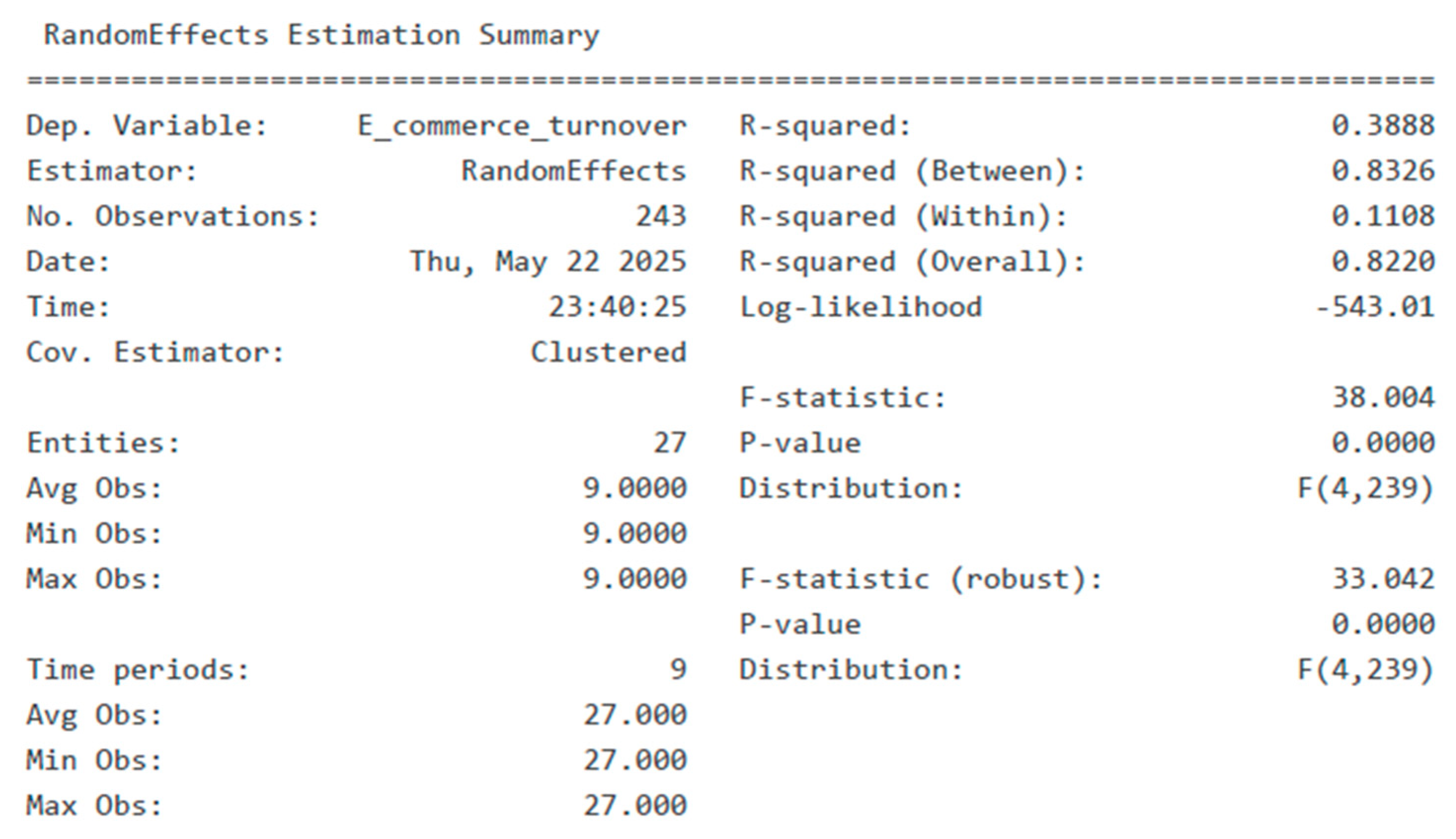
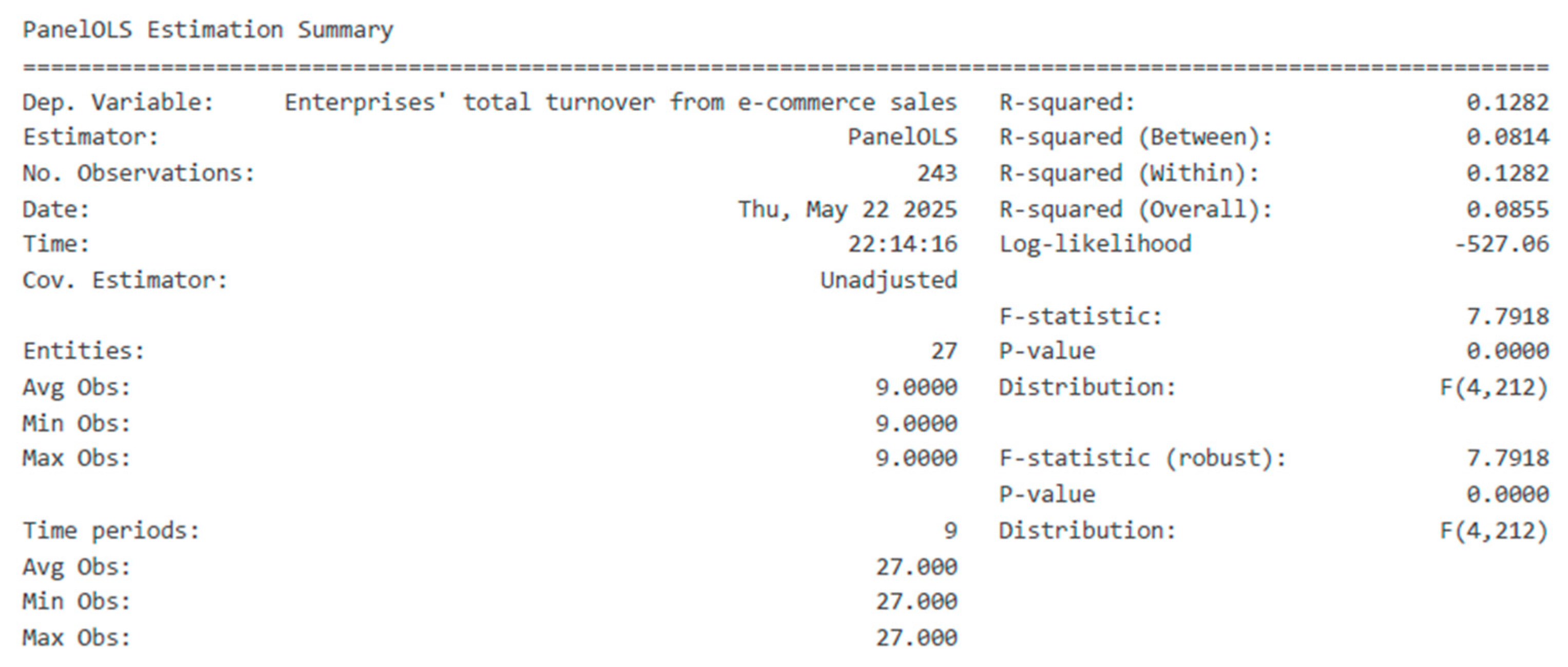
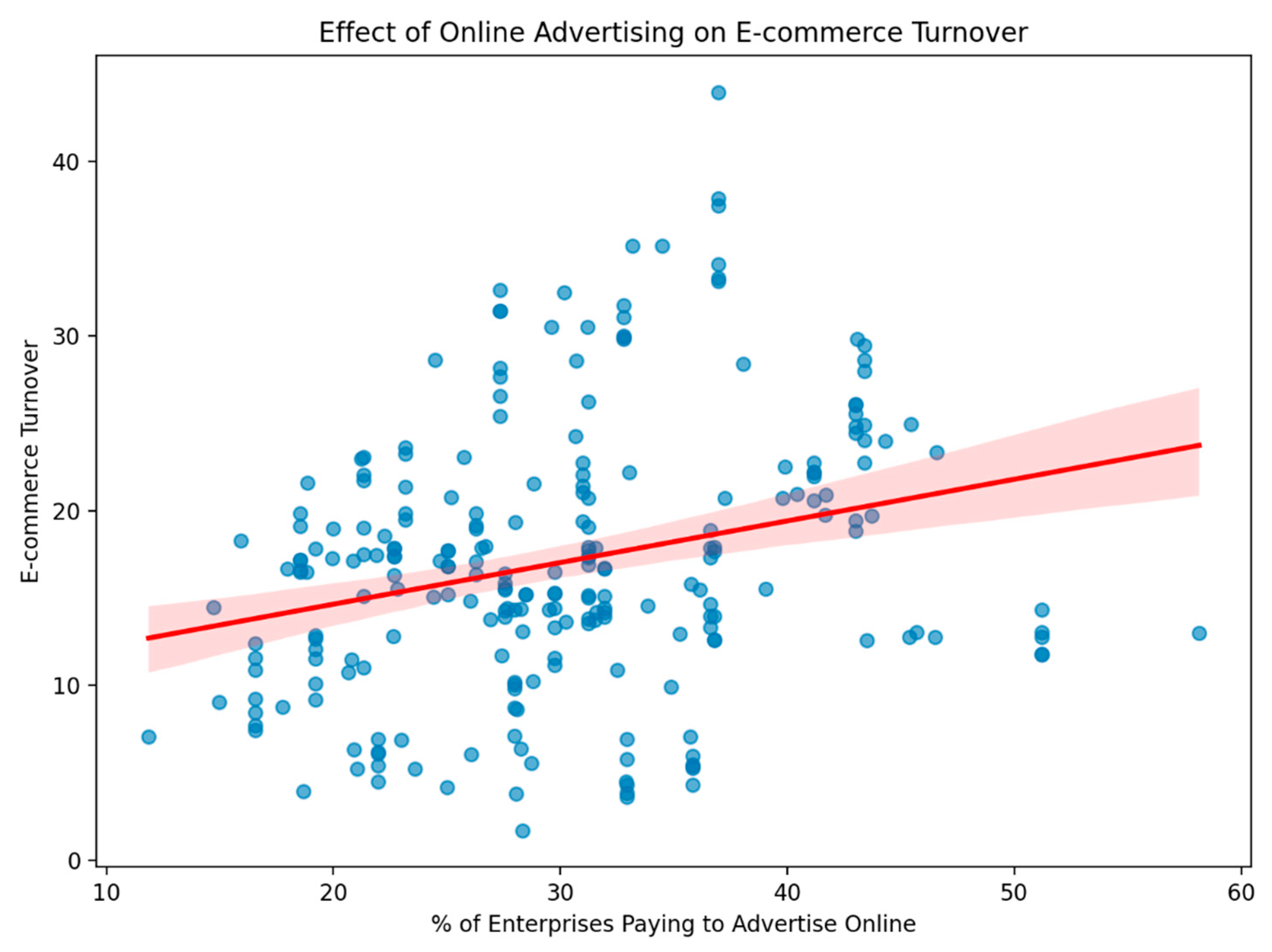

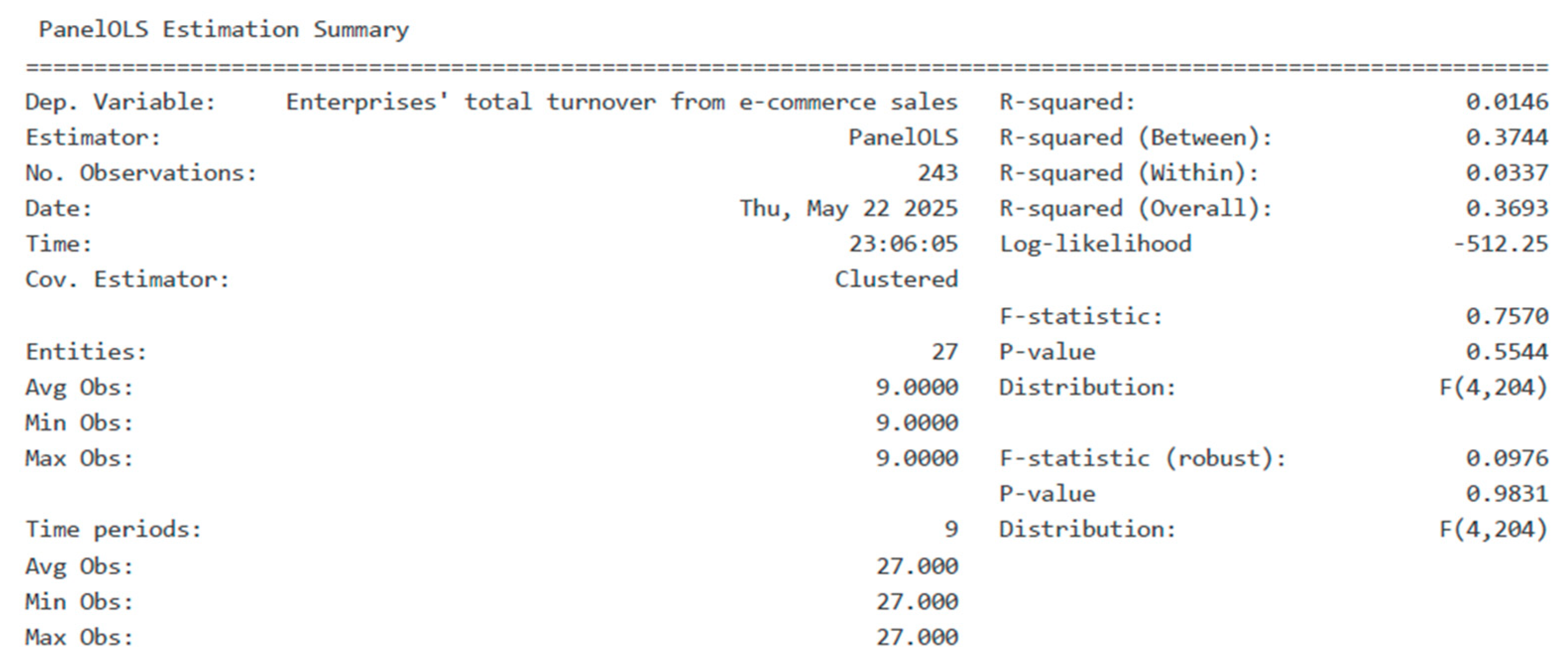
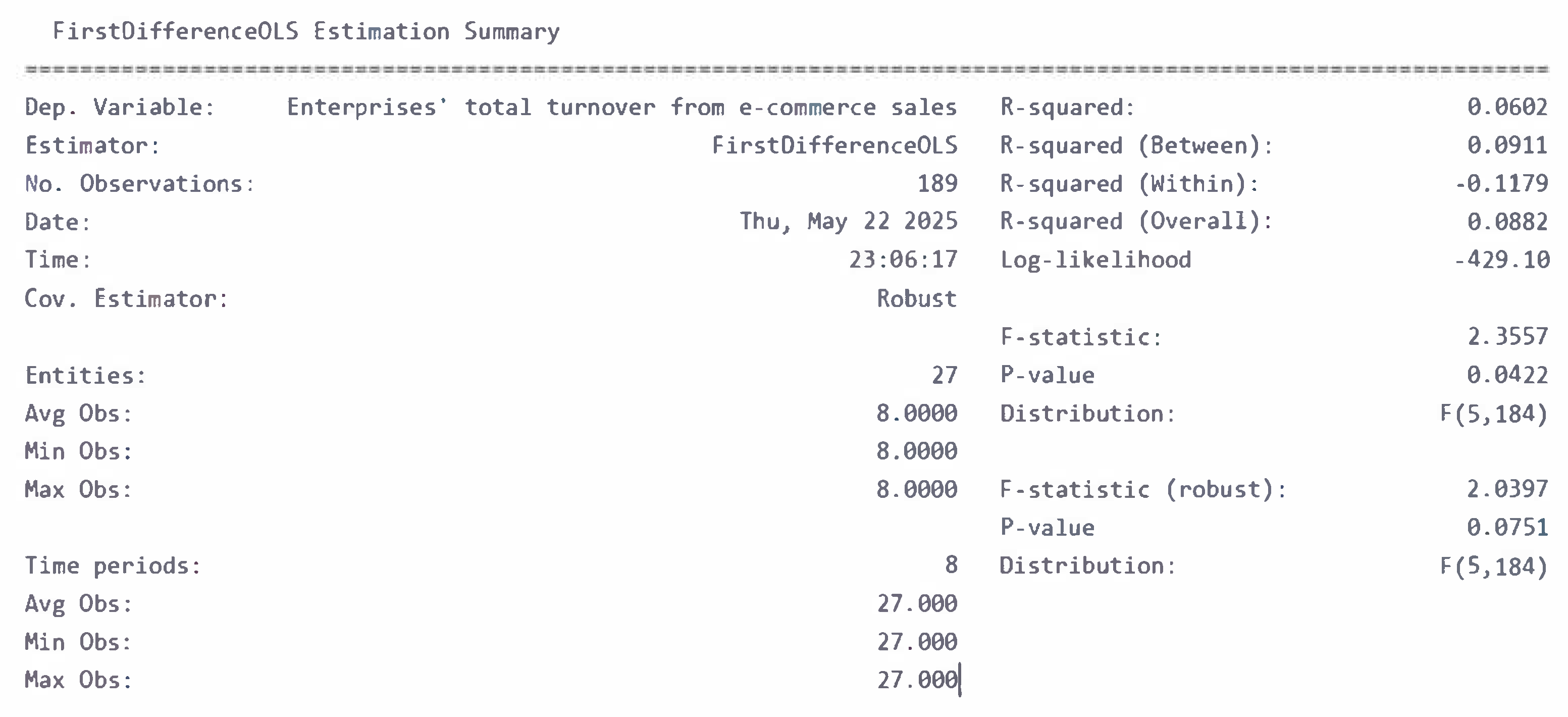
| Article | Subject of the Article | Number of Citations |
|---|---|---|
| Social commerce constructs and consumer’s intention to buy | E-commerce and consumers’ intention to buy online through an SEM quantitative methodology [2] | 491 |
| Understanding social commerce: A systematic literature review and directions for further research | Systematic literature review of social commerce [32] | 247 |
| Social commerce research: Definition, research themes, and the trends | User-centric research in the field of e-commerce [1] | 185 |
| The effects of Facebook browsing and usage intensity on impulse purchase in f-commerce | Data impulse purchases in the field of e-commerce [33] | 139 |
| No. | Variable | Variable Type | Data Source | Dataset |
|---|---|---|---|---|
| 1 | Enterprises’ total turnover from e-commerce sales | Dependent | Eurostat | Value of e-commerce sales by size class of enterprise; unit of measure: percentage of turnover |
| 2 | Pay to advertise on the internet | Independent | Eurostat | Social media use by type, internet advertising and size class of enterprise; unit of measure: percentage of turnover |
| 3 | Use social networks (e.g., Facebook, LinkedIn, Xing, Viadeo, and Yammer); use the enterprise’s blog or microblogs (e.g., Twitter and Present.ly); | Independent | Eurostat | Social media use by type, internet advertising and size class of enterprise; unit of measure: percentage of enterprises |
| 3 | use the enterprise’s blog or microblogs (e.g., Twitter and Present.ly) | Independent | Eurostat | Social media use by type, internet advertising and size class of enterprise; unit of measure: percentage of enterprises |
| 4 | Use multimedia content sharing websites (e.g., YouTube, Flickr, Picasa, and SlideShare). | Independent | Eurostat | Social media use by type, internet advertising and size class of enterprise; unit of measure: percentage of enterprises |
| Variable | Fixed Effects | Random Effects | Difference |
|---|---|---|---|
| Pay to advertise on the internet; | 0.1125 | 0.2754 | −0.1629 |
| Use social networks (e.g., Facebook, LinkedIn, Xing, Viadeo, and Yammer); | 0.0060 | 0.0793 | −0.0733 |
| Use the enterprise’s blog or microblogs (e.g., Twitter and Present.ly); | 0.0772 | 0.1177 | −0.0406 |
| Use multimedia content sharing websites (e.g., YouTube, Flickr, Picasa, and SlideShare). | −0.0077 | 0.0174 | −0.0251 |
| Coefficient | Std.Err | T-Stat | p-Value | Lower CI | Upper CI | |
|---|---|---|---|---|---|---|
| Pay to advertise on the internet; | 0.2754 | 0.0398 | 6.9135 | 0.0000 | 0.1969 | 0.3538 |
| Use social networks (e.g., Facebook, LinkedIn, Xing, Viadeo, and Yammer); | 0.0793 | 0.0248 | 3.1938 | 0.0016 | 0.0304 | 0.1283 |
| Use the enterprise’s blog or microblogs (e.g., Twitter and Present.ly); | 0.1177 | 0.1248 | 0.9435 | 0.3464 | −0.1281 | 0.3635 |
| Data Use multimedia content sharing websites (e.g., YouTube, Flickr, Picasa, and SlideShare). | 0.0174 | 0.0111 | 1.5670 | 0.1184 | −0.0045 | 0.0392 |
| Coefficient | Std.Err | T-Stat | p-Value | 95% CI Lower | 95% CI Upper | |
|---|---|---|---|---|---|---|
| Const | 7.2915 | 2.3578 | 3.0925 | 0.0023 | 2.6437 | 11.9393 |
| Pay to advertise on the internet; | 0.1583 | 0.067 | 2.3621 | 0.0191 | 0.0262 | 0.2905 |
| Use social networks (e.g., Facebook, LinkedIn, Xing, Viadeo, and Yammer); | 0.0741 | 0.025 | 2.9595 | 0.0034 | 0.0247 | 0.1235 |
| Use the enterprise’s blog or microblogs (e.g., Twitter and Present.ly); | 0.039 | 0.0891 | 0.4377 | 0.6621 | −0.1367 | 0.2147 |
| Use multimedia content sharing websites (e.g., YouTube, Flickr, Picasa, and SlideShare). | 0.0151 | 0.0149 | 1.0128 | 0.3123 | −0.0143 | 0.0445 |
| Coefficient | Std.Err | T-Stat | p-Value | Lower CI | Upper CI | |
|---|---|---|---|---|---|---|
| Pay to advertise on the internet; | 0.1125 | 0.0683 | 1.6474 | 0.1010 | −0.0221 | 0.2471 |
| Use social networks (e.g., Facebook, LinkedIn, Xing, Viadeo, and Yammer) | 0.0060 | 0.0571 | 0.1060 | 0.9157 | −0.1065 | 0.1186 |
| Use the enterprise’s blog or microblogs (e.g., Twitter and Present.ly) | 0.0772 | 0.1257 | 0.6140 | 0.5399 | −0.1706 | 0.3250 |
| Use multimedia content sharing websites (e.g., YouTube, Flickr, Picasa, and SlideShare) | −0.0077 | 0.0104 | −0.7408 | 0.4597 | −0.0282 | 0.0128 |
| Parameter | Std.Err | T-Stat | p-Value | Lower CI | Upper CI | |
|---|---|---|---|---|---|---|
| Pay to advertise on the internet | 0.1565 | 0.0641 | 2.4413 | 0.0156 | 0.0300 | 0.2830 |
| Use social networks (e.g., Facebook, LinkedIn, Xing, Viadeo, and Yammer) | −0.0057 | 0.0230 | −0.2468 | 0.8053 | −0.0510 | 0.0396 |
| Use the enterprise’s blog or microblogs (e.g., Twitter and Present.ly) | 0.0040 | 0.1372 | 0.0291 | 0.9768 | −0.2667 | 0.2747 |
| Use multimedia content sharing websites (e.g., YouTube, Flickr, Picasa, and SlideShare) | −0.0008 | 0.0086 | −0.0964 | 0.9233 | −0.0178 | 0.0161 |
| Lag turnover | −0.1728 | 0.0923 | −1.8730 | 0.0627 | −0.3548 | 0.0092 |
Disclaimer/Publisher’s Note: The statements, opinions and data contained in all publications are solely those of the individual author(s) and contributor(s) and not of MDPI and/or the editor(s). MDPI and/or the editor(s) disclaim responsibility for any injury to people or property resulting from any ideas, methods, instructions or products referred to in the content. |
© 2025 by the authors. Licensee MDPI, Basel, Switzerland. This article is an open access article distributed under the terms and conditions of the Creative Commons Attribution (CC BY) license (https://creativecommons.org/licenses/by/4.0/).
Share and Cite
Mazare, M.; Simion, C.-P. The Influence of Web 2.0 Tools on the Sustainable Development of E-Commerce: Empirical Evidence from European Union Countries. Sustainability 2025, 17, 6237. https://doi.org/10.3390/su17146237
Mazare M, Simion C-P. The Influence of Web 2.0 Tools on the Sustainable Development of E-Commerce: Empirical Evidence from European Union Countries. Sustainability. 2025; 17(14):6237. https://doi.org/10.3390/su17146237
Chicago/Turabian StyleMazare, Madalina, and Cezar-Petre Simion. 2025. "The Influence of Web 2.0 Tools on the Sustainable Development of E-Commerce: Empirical Evidence from European Union Countries" Sustainability 17, no. 14: 6237. https://doi.org/10.3390/su17146237
APA StyleMazare, M., & Simion, C.-P. (2025). The Influence of Web 2.0 Tools on the Sustainable Development of E-Commerce: Empirical Evidence from European Union Countries. Sustainability, 17(14), 6237. https://doi.org/10.3390/su17146237






